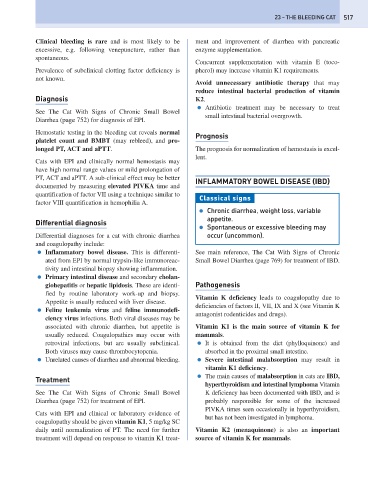Page 525 - Problem-Based Feline Medicine
P. 525
23 – THE BLEEDING CAT 517
Clinical bleeding is rare and is most likely to be ment and improvement of diarrhea with pancreatic
excessive, e.g. following venepuncture, rather than enzyme supplementation.
spontaneous.
Concurrent supplementation with vitamin E (toco-
Prevalence of subclinical clotting factor deficiency is pherol) may increase vitamin K1 requirements.
not known.
Avoid unnecessary antibiotic therapy that may
reduce intestinal bacterial production of vitamin
Diagnosis K2.
● Antibiotic treatment may be necessary to treat
See The Cat With Signs of Chronic Small Bowel
small intestinal bacterial overgrowth.
Diarrhea (page 752) for diagnosis of EPI.
Hemostatic testing in the bleeding cat reveals normal
Prognosis
platelet count and BMBT (may rebleed), and pro-
longed PT, ACT and aPTT. The prognosis for normalization of hemostasis is excel-
lent.
Cats with EPI and clinically normal hemostasis may
have high normal range values or mild prolongation of
PT, ACT and aPTT. A sub-clinical effect may be better
INFLAMMATORY BOWEL DISEASE (IBD)
documented by measuring elevated PIVKA time and
quantification of factor VII using a technique similar to
Classical signs
factor VIII quantification in hemophilia A.
● Chronic diarrhea, weight loss, variable
appetite.
Differential diagnosis
● Spontaneous or excessive bleeding may
Differential diagnoses for a cat with chronic diarrhea occur (uncommon).
and coagulopathy include:
● Inflammatory bowel disease. This is differenti- See main reference, The Cat With Signs of Chronic
ated from EPI by normal trypsin-like immunoreac- Small Bowel Diarrhea (page 769) for treatment of IBD.
tivity and intestinal biopsy showing inflammation.
● Primary intestinal disease and secondary cholan-
giohepatitis or hepatic lipidosis. These are identi- Pathogenesis
fied by routine laboratory work-up and biopsy.
Vitamin K deficiency leads to coagulopathy due to
Appetite is usually reduced with liver disease.
deficiencies of factors II, VII, IX and X (see Vitamin K
● Feline leukemia virus and feline immunodefi-
antagonist rodenticides and drugs).
ciency virus infections. Both viral diseases may be
associated with chronic diarrhea, but appetite is Vitamin K1 is the main source of vitamin K for
usually reduced. Coagulopathies may occur with mammals.
retroviral infections, but are usually subclinical. ● It is obtained from the diet (phylloquinone) and
Both viruses may cause thrombocytopenia. absorbed in the proximal small intestine.
● Unrelated causes of diarrhea and abnormal bleeding. ● Severe intestinal malabsorption may result in
vitamin K1 deficiency.
● The main causes of malabsorption in cats are IBD,
Treatment
hyperthyroidism and intestinal lymphoma Vitamin
See The Cat With Signs of Chronic Small Bowel K deficiency has been documented with IBD, and is
Diarrhea (page 752) for treatment of EPI. probably responsible for some of the increased
PIVKA times seen occasionally in hyperthyroidism,
Cats with EPI and clinical or laboratory evidence of
but has not been investigated in lymphoma.
coagulopathy should be given vitamin K1, 5 mg/kg SC
daily until normalization of PT. The need for further Vitamin K2 (menaquinone) is also an important
treatment will depend on response to vitamin K1 treat- source of vitamin K for mammals.

